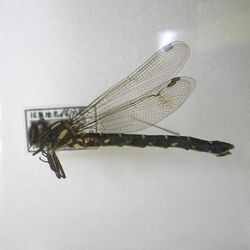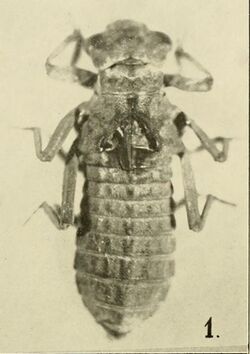Biology:Epiophlebia
| Epiophlebia | |
|---|---|

| |
| Epiophlebia superstes | |
| Scientific classification | |
| Domain: | Eukaryota |
| Kingdom: | Animalia |
| Phylum: | Arthropoda |
| Class: | Insecta |
| Order: | Odonata |
| Suborder: | Epiprocta |
| Infraorder: | Epiophlebioptera |
| Family: | Epiophlebiidae Tillyard, 1917 |
| Genus: | Epiophlebia Calvert, 1903 |
| Species | |
| |
The genus Epiophlebia is the sole member of the family Epiophlebiidae, which is itself the sole living representative of the Epiproctan infraorder Epiophlebioptera, and it contains only three species. The first two species were historically placed in their own suborder Anisozygoptera, considered intermediate between dragonflies and damselflies, mainly because the hind wings are very similar in size and shape to the forewings and held back over the body at rest, as in damselflies. It has more recently[when?] been recognized that the genus Epiophlebia shares a more recent ancestor with dragonflies (having become separated from these in and around the uplifting of the Himalayas[1][2]), and the group has accordingly been reclassified as an infraorder within the dragonflies.[3][failed verification] Very recently[4] a third species, Epiophlebia sinensis, has been described from Heilongjiang province in northeast China, bridging Epiophlebia distribution gap between Nepal and Japan. A fourth species has been claimed from larval material from South China, but this is not universally accepted.[5] Epiophlebia species are a freshwater indicator of a river ecosystem health.[6] A study that has been conducted on the head anatomy of Epiophlebia has verified the presence of 41 muscles in the head of the larva.[7] Like in true dragonflies (Anisoptera) the aquatic nymphs breathe through a rectal chamber, but jet propulsion has yet to be documented.[8] Epiophlebia species are a representative of a dragonfly fauna which originated during the Jurassic period on the rising continent of Eurasia.[9]
| Odonatoptera |
| |||||||||||||||||||||||||||||||||||||||||||||||||||||||||||||||||||||||||||||||||||||||||||||||||||
Cited references
- ↑ Tillyard R J (1921). "On an Anisozygopterous Larva from the Himalayas (Order Odonata)". Records of the Indian Museum 22 (2): 93–107. doi:10.5962/bhl.part.1469. https://archive.org/stream/recordsofindianm22indi#page/93/mode/1up/.
- ↑ Fraser FC (1934). Fauna of British India. Odonata. Volume 2. Taylor & Francis. p. 151. https://archive.org/stream/FraserOdonata2/odonata2#page/n174/mode/1up/search/Epiophlebia.
- ↑ Bybee, Seth M.; Kalkman, Vincent J.; Erickson, Robert J. et al. (2021). "Phylogeny and classification of Odonata using targeted genomics". Molecular Phylogenetics and Evolution (Elsevier BV) 160: 107115. doi:10.1016/j.ympev.2021.107115. ISSN 1055-7903.
- ↑ Li J.-K., Nel A., Zhang X.-P., Fleck G., Gao M.-X., Lin L. & Zhou J., 2012. A third species of the relict family Epiophlebiidae discovered in China (Odonata: Epiproctophora). Systematic Entomology, 37 (2):408-412
- ↑ Carle, F L (2012). "A new Epiophlebia (Odonata: Epiophlebioidea) from China with a review of epiophlebian taxonomy, life history, and biogeography". Arthropod Systematics Phylogeny 70 (2): 75–83. http://www.senckenberg.de/files/content/forschung/publikationen/arthropodsystematics/asp_70_2/01_asp_70_2_carle_75-83.pdf. Retrieved 2015-06-09.
- ↑ Nesemann, H F (2011). "Morphological characters of epiophlebia laidlawi tillyard larvae, with notes on the habitat and distribution of the species in Nepal". Odonatologica 40 (3): 191–202.
- ↑ Blanke, A (2014). "Coding characters from different life stages for phylogenetic reconstruction: a case study on dragonfly adults and larvae, including a description of the larval head anatomy of Epiophlebia superstes (Odonata: Epiophlebiidae)". Zoological Journal of the Linnean Society 174 (4): 718–732. doi:10.1111/zoj.12258.
- ↑ Büsse, Sebastian; Helmker, Benjamin; Hörnschemeyer, Thomas (2015). "The thorax morphology of Epiophlebia (Insecta: Odonata) nymphs – including remarks on ontogenesis and evolution". Scientific Reports 5: 12835. doi:10.1038/srep12835. PMID 26246088.
- ↑ Brockhaus, T (2009). "NEW RECORDS OF EPIOPHLEBIA LAIDLAWI TILLYARD IN BHUTAN, WITH NOTES ON ITS BIOLOGY, ECOLOGY, DISTRIBUTION, ZOOGEOGRAPHY AND THREAT STATUS (ANISOZYGOPTERA: EPIOPHLEBIIDAE)". Odonatologica 38 (3): 203–215. http://natuurtijdschriften.nl/download?type=document&docid=592664.
Wikidata ☰ {{{from}}} entry
 |


